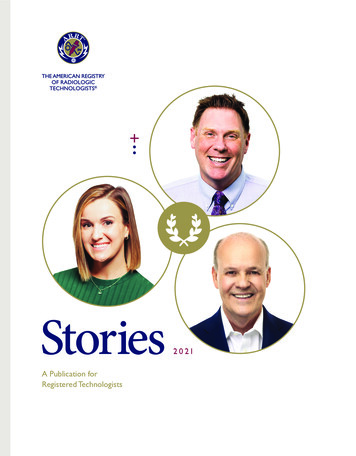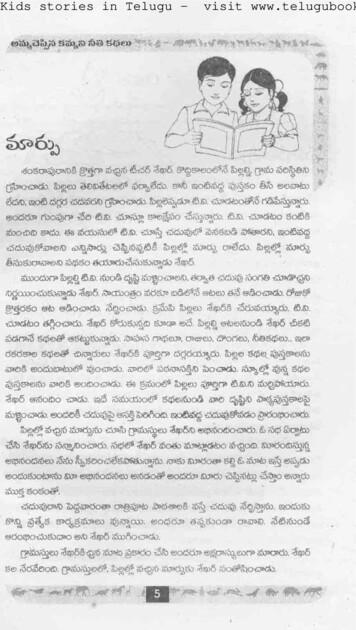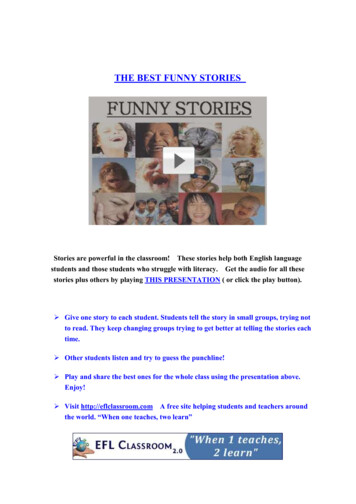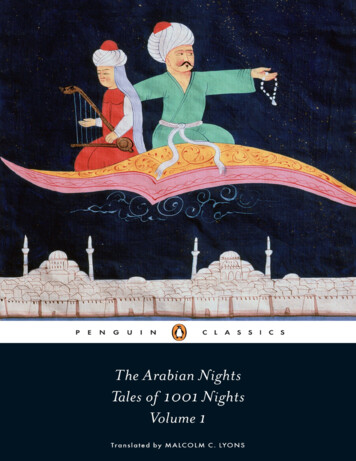
Transcription
StoriesA Publication forRegistered Technologists2 0 21
TABLE OF CONTENTSI AM THEGOLD STANDARD4I Am the Gold Standard WinnersJASON LEEROBERTO JUAN TELLERIAWe’ve sponsored the I Am the Gold Standard (IATGS) awards since 2016 to recognize RegisteredTechnologists—like you—who excel in your profession. Nominees must meet criteria in one or moreof the following categories: Quality and Safety; Patient Experience; Advocating for the Profession.R ACHEL WARD10This year’s IATGS nomination committee, composed of ARRT staff R.T.s, reviewed more than 100nominations from across the country and selected a winner in each of the following modalities: Jason Lee, R.R.A., R.T.(R)(CT)(ARRT), RPA, Medical ImagingHow to Nominate Someone11 Roberto Juan Telleria, R.T.(R)(CV)(CT)(ARRT), Interventional ProceduresI Am the Gold Standard FinalistsNews, Notes, and Important Links Rachel Ward, R.T.(T)(ARRT), Radiation TherapyOur winners receive airfare, hotel, and conference registration for a national society conferenceof their choice in the continental U.S.If you—or someone you know—deserves recognition, turn to Page 10 and learn how to takepart in our next awards program.2021 I Am the Gold Standard Awards Committee:Roxanne KoenenAnn MillerKellie ReynoldsKevin RushLiana WatsonB.S., R.T.(N)(ARRT),CNMT, PETBSRT, R.T.(R)(M)(ARRT),CSCJ.D., R.T.(R)(MR)(ARRT)MHA, R.T.(R)(T)(ARRT),FASRTDM, R.T.(R)(M)(S)(BS)(ARRT),RDMS, RVT, FASRT, PMP, CAEWe want to hear from you!Please scan this code to take a quick surveyabout Stories. Do you enjoy reading it? Are thereother topics you’d like us to address? Let us know!Your responses will help us plan next year’scommunications from ARRT.THE AMERICAN REGISTRY OF RADIOLOGIC TECHNOLOGISTS 3
As a Radiologist Assistant at Johns Hopkins,Lee specializes in pediatric care.Jason LeeR.R.A., R.T.(R)(CT)(ARRT), RPARadiologist Assistant, The Johns Hopkins HospitalX-Ray Technologist, PRN, Medstar HealthBaltimore, MarylandI AM THE GOLD STANDARDA Callingfor Care and KnowledgeWhen he was in seventh grade, Jason Lee required multiple MRIs and computedtomography (CT) scans that ultimately diagnosed pseudotumor cerebri—a condition with symptoms that mimic those of a brain tumor.Some teens would have wanted to put the experience behindthem as quickly as possible. Instead, Lee found a career. “Ithought the MRIs and CTs were pretty impressive,” he says.“They steered me into radiology.”Today, Lee holds two positions in radiology, has volunteeredfor several organizations, has published numerous articles,and has given many presentations. His devotion to patientcare and education earned him one of our 2021 I Am the GoldStandard awards.A Specialist in Pediatric CareAfter finishing a radiography program and earning his firstARRT credential, Lee began working on a bachelor’s degree inbiology. “I had plans to pursue a physician assistant specialty,”he says, “but then I heard about a radiologist practitionerassistant program that would enable me to build on myradiology skills.” That path enables him to perform selectedimaging procedures under a less-restrictive level of radiologistsupervision than is required for radiographers who aren’tradiologist assistants.4STORIES 2021As a radiologist assistant at Johns Hopkins, Lee specializesin pediatric care. “Because of the condition I had when I wasyoung, I understand what it feels like to be a patient,” he says.“Understanding how kids view things makes me empatheticto them and what they’re going through. I make sure to talk tothem on their level.”Lee also works as needed at Medstar Health, where he treatspatients who need urgent imaging care. Stephanie Kaldis,Regional Manager of Radiology Compliance at Medstar,nominated Lee for the Gold Standard award in part because ofthe way he interacts with patients.“He knows how to handle not justchildren, but also their parents, whoare anxious during stressful situations,”she says. “And I’ve seen him take timeto calm patients of all ages, even whenwe’re in a rush to provide care.”“ Because of the condition I had when I wasyoung, I understand what it feels like to bea patient. Understanding how kidsview things makes me empatheticto them and what they’re goingthrough. I make sure to talkto them on their level.”She adds that, during the COVID-19 pandemic, her staffhas experienced a great deal of burnout. “But Jason alwayspresents a calm and peaceful demeanor,” she says.Outside Work: Volunteering and EducationEven outside of his paid employment, Lee devotes much ofhis time in service to his profession. “Radiology is a hobby tohim,” Kaldis says. “It’s fun.”For example, Lee volunteers with RAD-AID, an organizationthat strives to improve access to medical imaging acrossthe globe. Before the COVID-19 pandemic, he traveled toMalawi, where he planned to give training on CT scans.“Unfortunately, they were having trouble with their scanner,”he says. Instead, he talked to technologists and residentsin-training there about quality assurance, quality controlprocesses, and protocols. “I hope to travel again when theCOVID restrictions change,” he says. “I’ll go back to Africa orsome other place that needs radiographic expertise.”Closer to home, Lee gives presentations through the MarylandSociety of Radiology Technologists and other organizations.He writes articles that serve as continuing education optionsfor health-care professionals, and he speaks to residents andmedical students regularly. “Outside of patient care, teachingis the most fulfilling part of my career,” Lee says. “I love toshare what I’ve learned over time.”He also serves on committees for the Maryland Board ofPhysicians and for ARRT, and he promotes the MedicareAccess to Radiology Care Act. “I live near Washington, D.C.,”he notes, “which makes it easy for me to meet lawmakers andother supporters of the bill in person when I need to.”In his spare time? Lee is nearing completion of a master’sdegree so he can pursue teaching at a university level. Thenhe’s considering a doctorate. “I value continuous learning,” hesays. “It gives me satisfaction and provides me with additionalknowledge to share.”At work, though, he says his greatest satisfaction comeswhen he receives a simple thank you. “When I’m done withan exam and I know the patient is comfortable and gotmuch-needed care, it’s exciting when the family thanks thestaff and me for being nice,” he says. “That constitutes asuccessful procedure for me.”THE AMERICAN REGISTRY OF RADIOLOGIC TECHNOLOGISTS 5
Telleria has spent more than40 years in interventional radiology.Roberto Juan TelleriaR.T.(R)(CV)(CT)(ARRT)Interventional Radiographer IVBaptist Hospital of South Florida, Miami, FloridaA LifelongCommitmentIn medicine, patient-care successes make the journey worthwhile. But it can takea while for them to become visible. That’s why Roberto Juan Telleria treasures thereal-time results he sees as an interventional radiographer.For example, he recalls the satisfaction of treating a patientwho had an ischemic stroke. “In that situation, there’s noblood flow through part of the brain,” he explains. “Thepatient doesn’t talk. He doesn’t react to you. Then you removethe clot—and he talks just like he did before the stroke.”Experiences like that are the reasons Telleria has spent morethan 40 years in interventional radiology.Telleria works at Miami Cardiac and Vascular Institute, partof Baptist Hospital of South Florida in Miami. Violeine St.Hilaire, Director of Nursing there, says she and her teamwere thrilled when Telleria won one of ARRT’s 2021 I Am theGold Standard awards. “We were all excited because of hishard work in our lab and in maintaining the integrity of theprofession,” she says.A Fortunate BeginningTelleria found his life’s work at only 15, when he watched histechnologist uncle process images in a darkroom. “It’s magicalto see something like that,” he says. Spellbound from the start,Telleria soon committed to the profession.6STORIES 2021He attended the Mount Sinai School of Radiology Technologyin Miami, a hospital-based training opportunity. He says itallowed him to receive critical hands-on learning in all areasof radiography. “The training is intense,” he says. “You spendeight hours each day working in the hospital. The knowledgeyou obtain is unbelievable.”When he graduated, the hospital had four job openings. “Ichose interventional,” he recalls. “You can see results on themonitor as you do the work. It’s amazing what we can do.”He worked at Mount Sinai Medical Center for 26 years, mostof it as a Special Procedure Technologist and seven years asTechnical Director of the radiology department. He moved toBaptist Hospital in 2002.An On-Call LifePatients who experience emergencies, such as strokes andgastrointestinal bleeding, require urgent interventions. Thatmeans Telleria has worked on-call and seen many late nightsthroughout his career. “Time is brain,” he says, referring to theneed for swift intervention. “The patient’s life is in your hands.”I AM THE GOLD STANDARD“ My goals have never changed. They areto be a hard worker, learn somethingnew every day, and always think,‘If I were the patient, how wouldI want to be treated?’”Even when patients arrive at the hospital soon afterexperiencing a stroke or other medical issue, however, positiveoutcomes aren’t guaranteed. “Those moments come withgreat responsibility and tension,” Telleria says. “But witnessinga patient begin to move and talk—or seeing bleeding stopon a monitor—because of a procedure makes that tensionworthwhile. Long hours and high pressure are part of the job,but lifesaving results are the reason we do it.”students now receive lectures on vascular interventional andneurological interventional radiology. Telleria volunteersas a clinical instructor and is a member of the college’sradiography advisory committee.A Focus on CommunityAt Baptist Health, he helped create a career ladder to helpreward technologists who have extra skills and responsibilities.St. Hilaire adds that Telleria always makes himself availableto visiting students and team members who need training.“He created a pipeline for students to come work with us if itpiques their interest,” she adds.It’s clear that Telleria values serving his community. Forexample, he gives lectures on stroke and volunteers at anannual stroke fair. There, he shows the symptoms of strokeand explains stroke care to attendees. In addition, he hasdonated his time as an educator, instructor, publisher, lecturer,continuing education sponsor, and item writer for ARRT.Telleria says his desire for improving processes andcontinuous learning comes from empathy for his patientsand a desire to help others. “My goals have never changed,”he says. “They are to be a hard worker, learn something newevery day, and always think, ‘If I were the patient, how wouldI want to be treated?’”When he noticed that interventional radiology wasn’tpart of students’ clinical rotations at Miami Dade CollegeMedical Campus, Telleria spearheaded adding the field tothe curriculum. “Without it, interventional radiology iscompletely foreign to students,” he explains. “They view it asa completely different profession.” As a result of his efforts,He nominated himself for the award largely to shine light onhis profession. “I do the same things other X-ray techs do,” hesays, “and I want to encourage the people who will be workingafter I retire. This is the highest award that one can obtain inmy profession. It culminates a career I’m proud of.”THE AMERICAN REGISTRY OF RADIOLOGIC TECHNOLOGISTS 7
Ward used Instagram to connect withothers and spread knowledge aboutsuperficial radiation therapy.Rachel WardR.T.(T)(ARRT)Radiation TherapistUlmer Dermatology—Long Beach, CaliforniaChartingHer Own WayWhen she was a new graduate, people advised Rachel Ward not topursue a career using superficial radiation therapy (SRT) to treat skin cancer.You’ll lose your skills, they said. There won’t be full-time work.Despite the warnings, Ward chose the less common path.Now she’s found success: in her work, on social media sharinginformation about her field, and as one of our 2021 I Am theGold Standard winners.Her employer and her patients’ sentiments reflect herachievements. “Patients have a lot of confidence in her,” saysher supervisor, Douglas Ulmer, M.D. “They look forwardto seeing her because she gets along with people easily andmakes them feel comfortable.”And her advocacy efforts on social media? “I gained more than2,000 followers in my first month,” Ward says. “That’s when Idecided to focus on how to become a radiation therapist, andon providing support and information about SRT.”Finding Her Less-Traveled PathAs a student, Ward says she struggled to find a course of studythat suited her. But when she shadowed a professional in alocal radiation oncology clinic, she found her future career.Soon she enrolled in the radiation therapy program at WayneState University in Detroit, Michigan.8STORIES 2021She ultimately joined Ulmer Dermatology in Long Beach,California, where she began working in SRT. “It’s notsomething many therapists do—or are even taught to do,”she says. “I saw one slide about SRT during a presentation inschool.” Just as many students don’t know of the treatment,Ward says, neither do many patients who have skin cancer.In addition to being painless, radiation helps patients avoidsurgeries and scars. Ward recalls treating a patient whoseskin cancer covered 80% of her nose. “SRT helped her avoida skin graft and facial reconstruction,” she says.“Nothing makes me happier thanwhen a patient doesn’t have to hidebehind bandages.”Creating an Online PresenceDuring the COVID-19 pandemic, she saw an opportunityto advocate for SRT on social media while sharing herknowledge about the treatment. She launched @rachthertt onInstagram to talk about skin cancer treatment and radiationI AM THE GOLD STANDARD“ I’ve encountered so many people whoare hesitant about entering the fieldbecause they know so little about it.I try to share as much as I can to helpeducate others and provide the bestcare possible for patients.”therapy education. In addition to answering individualmessages, she began posting infographics about SRT, skincancer, and a career as a radiation therapist.Since October 2020, Ward has built @rachthertt to more than5,000 followers. In addition, she began writing articles forSkinCancer.net.“My goal is to provide education onthe 3 P’s: patients, providers, andpotential students,” she says.Now that she’s received a Gold Standard award, she hopes heradvocacy and education efforts will go further. “As a student, Ididn’t have anyone to turn to for answers,” Ward says. “Now Ihope to be a mentor to anyone who needs information.”through anything without fully understanding the process,”she says. She adds that a doctor’s office can be intimidating.“People are overwhelmed with information,” she says.“They can be afraid to speak up about something they don’tunderstand. If I say, ‘Do you have any questions?’, they mightnot answer—but when I say, ‘What questions do you have?’,we start a conversation.”Ulmer says Ward is a skilled asset to the office. “Rachel’s anextraordinary person,” he says. “She has a lot of talents relatedto both radiation training and helping people.”Ward says she didn’t apply for the Gold Standard award topromote herself. But she hopes winning the award will expandher opportunities for advocacy and education. “I want to keepsharing information,” she says. “I’ve encountered so manypeople who are hesitant about entering the field because theyknow so little about it. I try to share as much as I can to helpeducate others and provide the best care possible for patients.”Providing Comprehensive Care andSpreading KnowledgeWard says it’s essential for patients to understand theirtreatment options. “It’s not acceptable to have patients goTHE AMERICAN REGISTRY OF RADIOLOGIC TECHNOLOGISTS 9
Congratulations to our 2021I Am the Gold Standard Finalists!PLEASE JOIN US IN RECOGNIZING THESE FINALISTSAdriann Al-GhishanR.T.(T)(ARRT)Michigan MedicineCorina “Cori” AmeenR.T.(R)(ARRT)CommonwealthHealthcare CorporationNorman GelladaR.T.(R)(CT)(ARRT)Cedars SinaiScott HaglundR.T.(R)(ARRT)St. Catherine UniversityStacy HarbersonR.T.(R)(N)(M)(CT)(ARRT)Howard Memorial HospitalRaynold HoR.T.(N)(ARRT)Kaiser Permanente/Loma Linda UniversitySydney KasnerR.T.(R)(M)(ARRT)Samaritan Health ServicesHugo ser PermanenteHoi Cheung ZhangR.T.(R)(MR)(ARRT)New York UniversityLangone HealthJeremy MillerR.T.(R)(CI)(VI)(ARRT)El Camino HospitalThat’s what R.T.s aspire to.It’s your turn to nominate a gold standardcolleague—or yourself.NOMINATIONS FOR I AM THE GOLD STANDARD OPEN IN JANUARY.ARRT’s I Am the Gold Standard awards recognize R.T.s who shine in the profession—whether that’s through exceptional patient care, innovations in quality and safety, oradvocacy for the profession.This year, Stephanie Kaldis of Medstar Health nominated Jason Lee, R.R.A., R.T.(R)(CT)(ARRT), RPA. “This was my first time nominating someone,” she says,“and the process was very easy. It makes me feel good that he gained an awardbecause of my nomination.”Feel good. Praise your colleagues. Nominate someone—or yourself—for I Am theGold Standard this January. Check out IAmTheGoldStandard.com this winter andmake your nomination.STORIES 2021Scan a QR code to go directly to our website.Bennell TrappGold Standard patient care.10News, Notes,& ImportantLinksHave a question? Connect withARRT through Message CenterTo open Message Center, log into your ARRT accountand click on the Messages link (next to the search icon).This tool makes it easier for you to correspond with usabout subjects such as maintaining your credentials,earning new ones, and completing official ARRT business.Want a printout of your credential(s)?It’s easy! Click on the Verify Credentials tab atthe top of the arrt.org home page.On a mobile device, click on the threehorizontal lines for a drop-down menu. Enter your first and last name underSearch Online Directory. Click on View Details next to your name. Click on the Print Verification button onthe top left corner of the pop-up box.NEWNews FeedStay up to date on ARRT news that’simportant for you to know.Stay current with ARRTon social mediaSearch for American Registry of RadiologicTechnologists on Facebook and LinkedIn. Followus for intriguing news and research on imaging,interventional procedures, and radiation therapy.You’ll also see which conferences we’re attendingand learn about important ARRT policy updates.Primary Eligibility Pathwayin Vascular SonographyARRT now offers a primary eligibilitypathway for Vascular Sonography (VS).That means students in a recognizedVS program can apply for certificationand registration after completing theireducational requirements.Volunteer Management SystemARRT recently launched a newvolunteer management system.It makes it easy to find and sign upfor volunteer opportunities with us.For more information about ARRT,visit arrt.org.THE AMERICAN REGISTRY OF RADIOLOGIC TECHNOLOGISTS 11
1255 Northland Drive, St. Paul, MN 55120The American Registry of RadiologicTechnologists promotes high standardsof patient care by recognizing qualifiedindividuals in medical imaging, interventionalprocedures, and radiation therapy.Headquartered in St. Paul, Minnesota,ARRT evaluates, certifies and annuallyregisters approximately 350,000 radiologictechnologists across the United States.For more information, visit arrt.org. 2021 The American Registry of Radiologic Technologists. All Rights Reserved.
When he noticed that interventional radiology wasn't part of students' clinical rotations at Miami Dade College Medical Campus, Telleria spearheaded adding the field to the curriculum. "Without it, interventional radiology is completely foreign to students," he explains. "They view it as a completely different profession."











